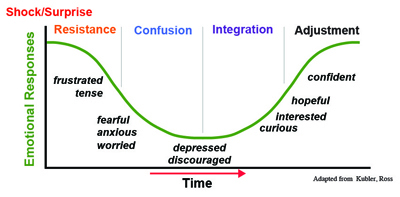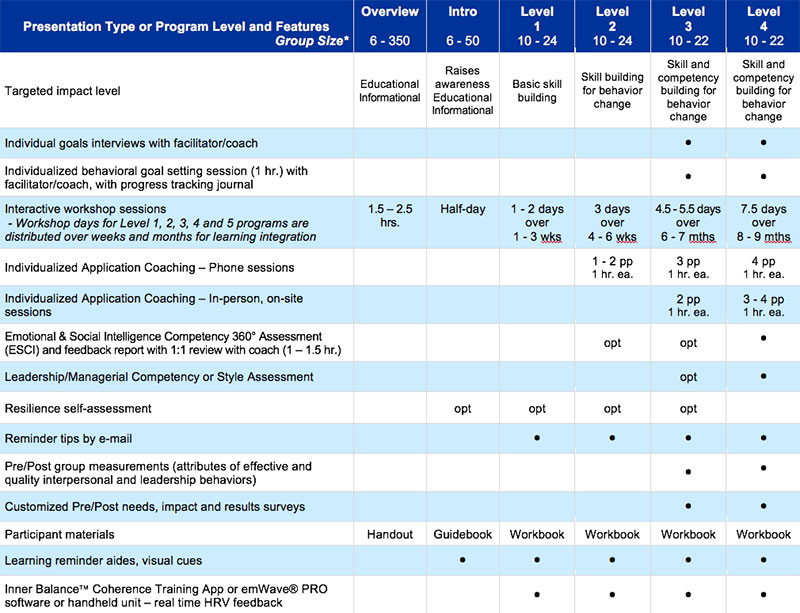Managing Change
It is not the strongest of the species that survive,
not the most intelligent, but the one most responsive to change.
– Charles Darwin, scientist
Managing Change
It is not the strongest of the species that survive,
not the most intelligent, but the one most responsive to change.
– Charles Darwin, scientist

Change is a constant today, but have we learned how to maximize our individual, team and organizational effectiveness in an environment of change?
Enable your people to increase resiliency and adaptability with training based on the latest scientific research, which shows we can interrupt limiting, reactive responses and access higher brain function for the most effective solutions.
Sustaining energy and focus; Building resiliency and agility
“Your first and foremost job as a leader is to take charge of your own energy and then to help orchestrate the energy of those around you.”
– Peter Drucker
- How well do your people sustain performance and focus as they move through a change process?
- How many change initiatives has your organization or team navigated in the past 2 – 3 years?
- Do your change management initiatives include building competence in and capacity for emotional self-regulation, resilience, adaptability, social awareness, empathy and influence?
Change of any kind requires the ability to flex and adapt to what is. Without this emotional flexibility, people operate in an internal environment of uncertainty, anxiety, frustration, victimization and stress — regardless of their skill in maintaining outward civility.
Re-engineering, reorganization, downsizing and rightsizing have created leaner and meaner enterprises, but it is debatable whether or not they are more effective organizations in terms of real quality.
CEOs report that 75% of substantial organizational change initiatives failed to produce the desired results. Factors include mis-steps in execution, absence of necessary structure and process, lack of understanding of the phases of change and lack of follow-through.
- 50% of the companies studied reported that the most difficult part of reengineering is dealing with fear and anxiety in their organizations.
- Of 99 completed reengineering initiatives, 67% were judged as producing mediocre, marginal, or failed results.
—1994 CSC Index “State of Reengineering Report”
Most people do not embrace change.
 There is safety for employees in holding on to what is familiar and continuing to operate within that framework, even if it does not adequately align with what will more effectively further the organization’s growth and success, or even when it is sub-optimum or unhealthy. Growth and success bring with them challenges, even when the changes are positive.
There is safety for employees in holding on to what is familiar and continuing to operate within that framework, even if it does not adequately align with what will more effectively further the organization’s growth and success, or even when it is sub-optimum or unhealthy. Growth and success bring with them challenges, even when the changes are positive.
Since change is going to continue in the work environment, and is accelerating at a rapid pace, it is important to recognize the impact on the people within the system and therefore the effects upon the organization’s capacity to maintain delivery of core competencies.
Effective movement through change depends upon leaders who are able to:
- Demonstrate resilience
- Recognize and understand what emotions and effects they are feeling and why
- Self-regulate stressful emotions and effects to maintain focus on the highest-value priorities
- Recognize and understand what others are feeling and how they are being affected by change or set-backs
- Influence and lead others for engagement and to navigate change most effectively for sustained performance
Phases of Change
 “Change” is not a single event people go through, but rather several changes, which occur one after the other. Typically, with each subsequent phase of the change, peoples’ emotional responses sink lower and lower with a much longer, harder climb out of the trench of anxiety, worry and depression.
“Change” is not a single event people go through, but rather several changes, which occur one after the other. Typically, with each subsequent phase of the change, peoples’ emotional responses sink lower and lower with a much longer, harder climb out of the trench of anxiety, worry and depression.
With most changes in organizational life people go through phases: resistance, confusion, integration and adjustment. Resistance occurs both internally and externally and is followed by some amount of confusion. Confusion is also experienced and expressed by people both internally and externally.
Whatever change model one examines, what is common and of critical importance to all of them is that people typically experience negative emotional responses – some for a long period of time – before they pull themselves out of it.
And that – the time it takes, and the depth of the negative emotions – can prevent the needed changes from occurring as quickly and smoothly as needed for business to effect their strategies.
The Hidden Costs
Often it is not the events themselves; it is the inefficient reactions people have in response to them. If a change is perceived as negative, or accompanied by a feeling of lack of control, costly consequences can result. Negative emotions of frustration, fear, anxiety, anger, confusion and depression drain energy, diminishing personal effectiveness. Left unchecked, these challenges can lead to a downward spiral of inefficiency, increased errors and “re-work”. Productivity can decline with time and energy misdirected in conflict, rumors, complaints and speculation about decisions and organizational initiatives.
“Organizational change causes productive work to drop from 4.8 hours per day to 1.2 hours per day, a loss of 75%. – U.S. Dept. of Labor
Science has proven that as pressure and stress increase, our capacity to perform (think rationally and intelligently) is compromised. Core competencies can collapse in a heartbeat.
- Perceptions become skewed and emotional reactivity is displayed.
- Big picture, strategic awareness is narrowed to individual or short-term survival perspective.
- Ineffective decision-making increases.
- Communication breakdowns occur and teamwork is fractured.
- Internal and external customer service quality is adversely affected.
- Stamina and energy are depleted.
- Quality breaks down in a domino effect: loss of focus, lowered productivity, higher inefficiency, low morale, higher turnover and absenteeism, poor customer service, increased costs, lower profits and shareholder value.
On the other hand, when mental and emotional turmoil are managed, increased physiological coherence results. This becomes an optimal physiological state for performance, learning, understanding and improved mental and emotional clarity.
Individual and team performance and comprehensive success depends on the individual’s ability to manage him/herself emotionally through changes. When the talent-holders in an organization have developed competencies of emotional self-awareness, self-regulation, and adaptability they are able to respond more effectively to change and sustain higher degrees of resiliency and focus.
Organizational change does not have to result in high levels of stress, anxiety, apathy, chaos and fear that drains productivity.
More than ever, the ability to lead while remaining balanced, clear-headed and focused, is a core competency central to moving through change and emerging with more coherence.
People can learn to access this strength when facing moment-to-moment challenges and unpredictable events. This program teaches how to quickly connect with expanded levels of perception and mental clarity, to operate at higher and more efficient levels of intelligence.
Benefits & Applications:
- Manage change without losing ground; Sustain positive outlook and motivation.
- Lead from a place of balance and clear-headed focus.
- Learn the latest findings from neuroscience on how the emotional reactions present during periods of change become stimulated and quickly inhibit higher brain function.
- Learn how our perceptions of events can set off a physiological chain reaction that will either facilitate or inhibit our capacity to think coherently and intelligently.
- Learn and apply scientifically-validated tools to override these reactions for greater focus and productivity by quickly changing negative, draining reactions into proactive, efficient responses.
- Help people move from apathy, immobilization and victimization to empowerment and ownership.
- Build flexibility, adaptability and resilience.
- Maintain productivity & effectiveness.
- Decrease fatigue and burnout. Sustain higher levels of energy and mental clarity.
- Reduce procrastination and improve decision making.
- Learn techniques to by-pass linear thought processing for creative approaches.
- Improve selected emotional intelligence competencies and avoid emotional reactivity.
- Maintain effective communication during periods of uncertainty.
Managing Change Programs

Features and Program Formats


